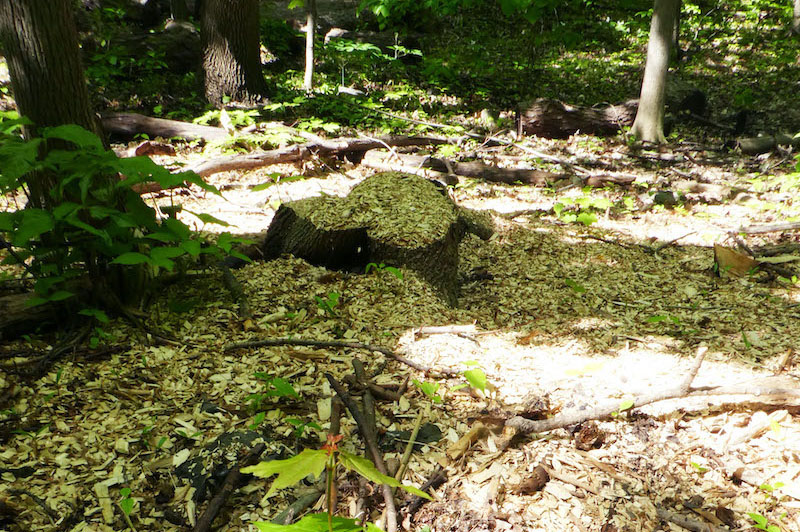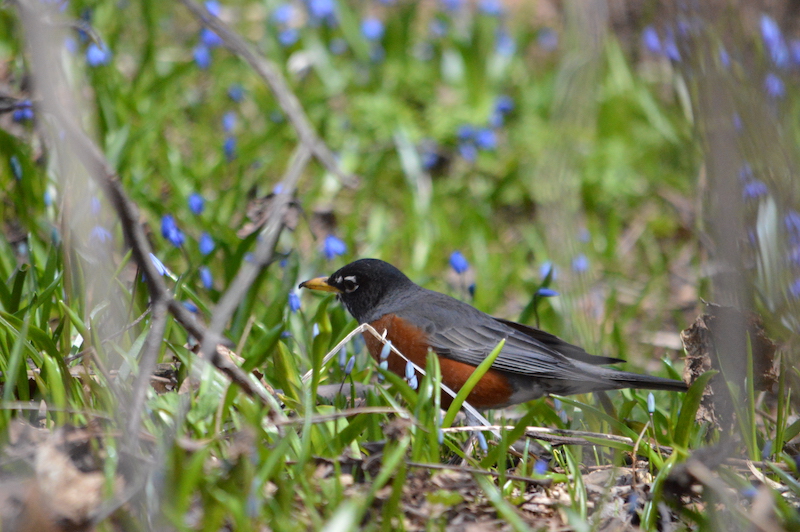Emerald Ash Borer: Why it’s Hard to See the Forest for the (Felled) Trees
- May 06, 2020
Now that spring has sprung on the mountain, more and more visitors are noticing piles of wood chips on the ground as well as gaps in the woods caused by the recent felling of trees. These are the results of the campaign against the emerald ash borer, which has been carried out on the mountain since 2017 to help protect the woodlands of Mount Royal.

photo: Antonin St-Jean
Fighting against the Emerald Ash Borer
Initiated by the City of Montréal, this vast operation to limit the impact and spread of the emerald ash borer has led to the cutting of thousands of dying ash trees in the forests of Mount Royal. In parallel, healthy ash trees were treated to protect them from infestation and prolong their survival. After three years, approximately 30% of the 10,200 ash trees* on the mountain are healthy, but this might change in the coming years since the treatment is not 100% effective and must be renewed every two years. Consequently, more trees will have to be cut down.

Cutting and Shredding Infested Trees to Better Protect the Forest
Tree cutting is done in the winter to limit the impact on natural environments. Branches and small trees were shredded on site to remove any living borer larvae and to conserve biomass. The wood chips were then spread in thin 10-cm piles, which can be easily seen in the park now that the snow has melted (because the snow doesn’t melt as quickly under the wood chips, the layer appears thicker than it is). These debris promote soil organisms (invertebrates and insects), fungi and microorganisms that will decompose the matter quickly and enrich the soil for plants to grow. They also protect the soil’s rich humus from the sun’s rays and from being washed out by heavy rains. Various plants and seeds will make their way through the wood chips, which will be less visible in a few months.
Let the Sunshine in!
The openings in the canopy created by cutting down dying ash trees allow more light to reach the ground, which favours the growth of vegetation. Tree and shrubs plantings have been carried out since 2018 to support this natural regeneration and prevent the growth of invasive species.

photo: Richard St-Jean
However, for the regeneration of the forest to be successful, it is important for visitors to stay on existing park trails or even to opt for Olmsted Path in the next few weeks. The very moist soil in spring is particularly sensitive to compaction, and it only takes a few people to damage or kill roots and small plants. In the mountain’s steeper zones, this compaction leads to soil erosion and, ultimately, the death and fall of larger trees.
The emerald ash borer infestation has had a major impact on the urban environment, affecting Mount Royal and elsewhere in the city. In the coming days and weeks, with the help of Mother Nature, the mountain will slowly turn green again and its natural environments will flourish, erasing the traces left by the cuts.
* Survey carried out in 2017
Back 
photo: Antonin St-Jean
Fighting against the Emerald Ash Borer
Initiated by the City of Montréal, this vast operation to limit the impact and spread of the emerald ash borer has led to the cutting of thousands of dying ash trees in the forests of Mount Royal. In parallel, healthy ash trees were treated to protect them from infestation and prolong their survival. After three years, approximately 30% of the 10,200 ash trees* on the mountain are healthy, but this might change in the coming years since the treatment is not 100% effective and must be renewed every two years. Consequently, more trees will have to be cut down.

Cutting and Shredding Infested Trees to Better Protect the Forest
Tree cutting is done in the winter to limit the impact on natural environments. Branches and small trees were shredded on site to remove any living borer larvae and to conserve biomass. The wood chips were then spread in thin 10-cm piles, which can be easily seen in the park now that the snow has melted (because the snow doesn’t melt as quickly under the wood chips, the layer appears thicker than it is). These debris promote soil organisms (invertebrates and insects), fungi and microorganisms that will decompose the matter quickly and enrich the soil for plants to grow. They also protect the soil’s rich humus from the sun’s rays and from being washed out by heavy rains. Various plants and seeds will make their way through the wood chips, which will be less visible in a few months.
Let the Sunshine in!
The openings in the canopy created by cutting down dying ash trees allow more light to reach the ground, which favours the growth of vegetation. Tree and shrubs plantings have been carried out since 2018 to support this natural regeneration and prevent the growth of invasive species.

photo: Richard St-Jean
However, for the regeneration of the forest to be successful, it is important for visitors to stay on existing park trails or even to opt for Olmsted Path in the next few weeks. The very moist soil in spring is particularly sensitive to compaction, and it only takes a few people to damage or kill roots and small plants. In the mountain’s steeper zones, this compaction leads to soil erosion and, ultimately, the death and fall of larger trees.
The emerald ash borer infestation has had a major impact on the urban environment, affecting Mount Royal and elsewhere in the city. In the coming days and weeks, with the help of Mother Nature, the mountain will slowly turn green again and its natural environments will flourish, erasing the traces left by the cuts.
* Survey carried out in 2017
